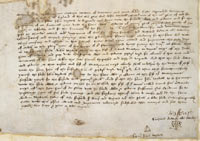 |
 |
 |
 |
 |
 |
 |
|
Byland Abbey: History
Byland Abbey: Buildings
|
On the brink of surrender: Byland in the sixteenth century Little is known of monastic life at Byland on
the eve of the Dissolution, but scattered references to the monks
offer some insight to the community and their activities at this
time. The abbot and monastic officials were extensively involved
in administrative affairs relating to the Order and also more generally.
For example, both the abbot and prior of Byland attended the election
of the abbot of Rievaulx in
1533. In 1525 Thomas Bolton (Poulton), the sacrist of
Byland, and Christopher Raner, a monk of the house, witnessed the
will of Alice Chaufer of Newstead.(71) Abbot John of
Byland was assigned the unpleasant task of presiding over the election
of a new abbot at Rievaulx, following the rather unjust and controversial
removal of Abbot Kirkby in
1533. Most of the Rievaulx monks objected to the appointment of
a new abbot, and Abbot John faced a difficult
challenge. John’s attempts to disengage himself from the
job resulted in a blunt and pointed letter from Cromwell, ordering
him to complete the task to which he had been appointed.(72)
Numbers at Byland were low in the sixteenth century, as elsewhere in the country, yet the monastery had its fair share of miscreants. One such offender may have been John of Cleveland, who was moved from Byland to Roche c. 1532, but had returned by 1535 when he was ordained to the priesthood.(73) It was common for those who had committed misdemeanours to be transferred, temporarily, to another community, in the hope that this short break would effect a transformation of character. It was probably for this reason that Christopher Crombock was moved from Whalley to Byland and it was certainly the reason for the arrival of Gawain Borodall from Holmcultram, who had allegedly poisoned his abbot. Not surprisingly Abbot John of Byland was less than thrilled to receive custody of this miscreant.(74) Surviving wills can also shed some light on the members of the monastic community at this time. Monks of Byland are sometimes named as beneficiaries or executors of their families’ wills, suggesting that they might retain close links with their kin. Marmaduke Christalowe, a monk of Byland, was named as a supervisor of his brother’s will and was to receive a horse upon his brother, William’s, death.(75) |
